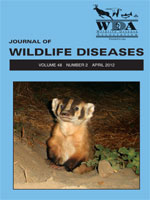In 2007, we assessed whether trapping method influenced apparent prevalence of low pathogenic avian influenza viruses (AIV) in wild ducks sampled during Canada’s Inter-agency Wild Bird Influenza Survey. Combined cloacal and oropharyngeal swabs were collected from 514 ducks captured by bait trapping (356) and netting from airboats (158), and tested by real-time reverse transcriptase polymerase chain reaction for influenza type A viruses. When controlling for species and capture site, ducks caught in bait traps were 2.6 times more likely to test positive for AIV compared with those netted from airboats (95% CI=1.2–6.0). If bait trapping increases AIV transmission among artificially aggregated ducks, this could have important implications for interpretation of disease surveillance results and waterfowl management programs.
How to translate text using browser tools
1 April 2012
Bait Trapping Linked to Higher Avian Influenza Virus Detection in Wild Ducks
Catherine Soos,
E. Jane Parmley,
Keith McAloney,
Bruce Pollard,
Emily Jenkins,
Fred Kibenge,
Frederick A. Leighton
ACCESS THE FULL ARTICLE

Journal of Wildlife Diseases
Vol. 48 • No. 2
April 2012
Vol. 48 • No. 2
April 2012
avian influenza virus
bait trap
Canada
detection
ducks
waterfowl




